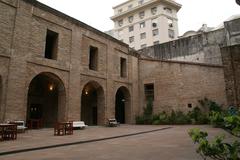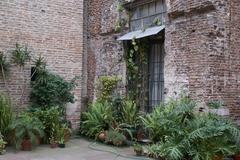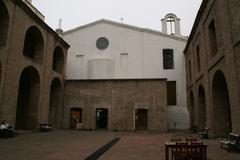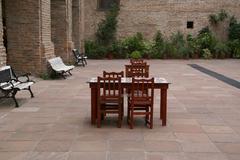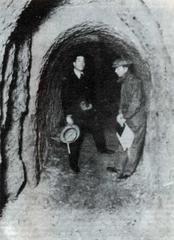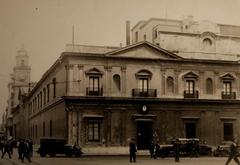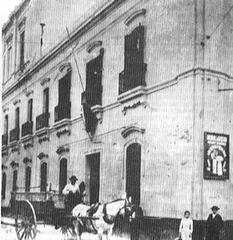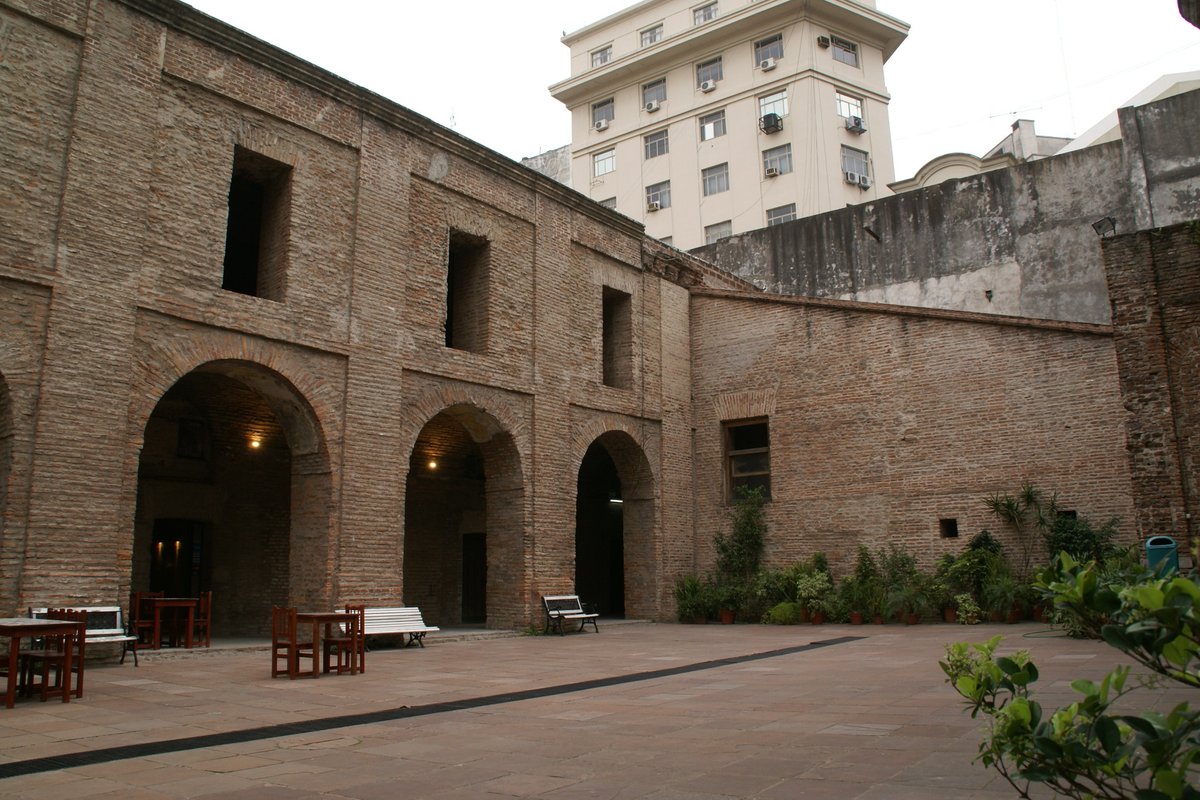
Illuminated Block (Manzana de las Luces): Visiting Hours, Tickets & Historical Sites in Buenos Aires
Date: 14/06/2025
Introduction
The Manzana de las Luces, or Illuminated Block, stands at the crossroads of Buenos Aires’ history, architecture, and culture. Located in the heart of the Montserrat neighborhood, this iconic block invites visitors to explore Argentina’s colonial heritage, intellectual evolution, and political milestones. From its 16th-century origins to its current role as a cultural and educational hub, the Illuminated Block is an essential destination for travelers seeking to understand Buenos Aires’ past and present (hollymelody.com; 4rentargentina.com).
This guide provides a detailed overview of the site’s historical significance, key architectural features, visitor information—including hours, ticketing, and tours—plus travel tips and recommendations to maximize your experience at one of Buenos Aires’ most treasured historic locations.
Historical Overview: Origins and Early Development
The Illuminated Block traces its roots to the Spanish refoundation of Buenos Aires in 1580. Its name, “Manzana de las Luces” or “Block of Lights,” references both the street lamps that once illuminated the area and the vibrant intellectual environment fostered by its institutions. By the 17th century, the Jesuits had established a strong presence, founding the Jesuit College (1661) and the Church of San Ignacio (completed in 1722), which became the religious and educational heart of the city (hollymelody.com; 4rentargentina.com).
Architectural Highlights
The Illuminated Block is a showcase of colonial, baroque, and neoclassical architecture. Notable structures include:
- San Ignacio Church: Built between 1686 and 1722, it is Buenos Aires’ oldest standing church, displaying baroque design and Jesuit craftsmanship (hollymelody.com).
- Jesuit College and Cloisters: Characterized by original adobe walls, cloistered courtyards, and arched galleries.
- Sala de Representantes: The legislative chamber where crucial 19th-century political events unfolded (4rentargentina.com).
- 18th-century Tunnels: A network beneath the block, historically used for communication and defense, accessible today via guided tours (Introducing Buenos Aires; WhichMuseum).
Other important buildings include viceregal houses and the old Customs House, adding depth to the block’s historical narrative.
Cultural and Political Significance
The Manzana de las Luces was instrumental in shaping Argentina’s identity:
- Intellectual Hub: Home to the prestigious Colegio Nacional de Buenos Aires and early faculties of the University of Buenos Aires, nurturing many national leaders (4rentargentina.com).
- Political Landmark: Site of the 1810 Cabildo de Buenos Aires, where the nation’s first independent government was formed, and the Sala de Representantes, which hosted foundational legislative sessions (hollymelody.com).
- Cultural Activities: Today, the block hosts concerts, art exhibitions, tango classes, and literary events, continuing its tradition as a cultural nucleus (Introducing Buenos Aires).
Visiting the Manzana de las Luces: Hours, Tickets & Tours
- Opening Hours: Generally open Tuesday to Sunday, 10:00 AM to 6:00 PM; closed on Mondays and select public holidays (Welcome Argentina; turismo.buenosaires.gob.ar).
- Admission: Entry is free to most areas. Guided tours, particularly those accessing the tunnels, require advance booking and a ticket (available on-site or online).
- Languages: Tours are primarily in Spanish. English tours may be available on weekends or by request (turismo.buenosaires.gob.ar).
- Accessibility: Main courtyards and some buildings are wheelchair accessible, but tunnels and certain historic sections have limited access. Contact ahead for specific accommodations.
- Photography: Allowed in public areas; restrictions may apply in sensitive spaces—always confirm with staff before taking photos.
- Facilities: Restrooms and refreshment kiosks are available. The surrounding Montserrat and San Telmo neighborhoods offer a variety of dining and lodging options.
Travel Tips and Nearby Attractions
- Getting There: Easily accessible via Subte stations Perú (Line A) and Bolívar (Line E), multiple bus lines, and taxis (Welcome Argentina).
- Nearby Sites: Plaza de Mayo, Metropolitan Cathedral, Casa Rosada, and San Telmo Market are within walking distance (solsalute.com).
- Best Times to Visit: Weekday mornings for fewer crowds; spring and early autumn for the best weather (wanderingnomada.com).
- Safety: The area is generally safe, especially during the day. Standard precautions against pickpocketing are advised in crowded places (myadventuresacrosstheworld.com). Use official taxis or ride-hailing options after dark.
FAQs: Illuminated Block Visiting Hours, Tickets, and More
Q: What are the opening hours?
A: Typically Tuesday to Sunday, 10:00 AM to 6:00 PM; closed Mondays.
Q: Is there an entrance fee?
A: General admission is free; guided tours and special exhibitions may require tickets.
Q: Are guided tours available in English?
A: Most tours are in Spanish; English tours may be offered on weekends or by prior arrangement.
Q: Is the site accessible for visitors with disabilities?
A: Partial accessibility; tunnels and some historic structures have limited access.
Q: How can I book tickets?
A: Tickets can be reserved via the official website or purchased on-site.
Suggested Itineraries and Visitor Experience
- Start at the San Ignacio Church for an introduction to colonial baroque architecture.
- Explore the Jesuit College and cloisters, then visit the Sala de Representantes.
- Join a guided tour to access the underground tunnels and hear stories of intrigue and defense.
- Stroll the courtyards and enjoy rotating exhibitions, then head to nearby Plaza de Mayo or San Telmo for a broader historical perspective.
Enhance Your Visit
- Bring a camera (no flash in sensitive areas) to capture the unique blend of architecture and ambiance.
- Check the official agenda for special events, exhibitions, or cultural workshops.
- Download the Audiala app for guided audio tours and updates on current cultural happenings.
Summary and Final Tips
The Manzana de las Luces is a cornerstone of Buenos Aires’ historical and cultural landscape, offering free access to centuries-old architecture, educational institutions, and underground mysteries. Its central location, rich programming, and connection to Argentina’s intellectual and political history make it a must-see for visitors. Plan ahead by consulting the official website for current hours and ticket policies, book a guided tour for deeper insights, and take advantage of nearby attractions to round out your exploration of Buenos Aires’ illuminated heritage.
Sources and Further Reading
- Manzana de las Luces (Illuminated Block) Buenos Aires: Visiting Hours, Tickets & Historical Guide, 2025, hollymelody.com (hollymelody.com)
- Manzana de las Luces The Historical Block of Buenos Aires, 2025, 4rentargentina.com (4rentargentina.com)
- Illuminated Block Buenos Aires: Visiting Hours, Tickets & Historical Insights, 2025, Introducing Buenos Aires (Introducing Buenos Aires)
- Illuminated Block Buenos Aires, 2025, WhichMuseum (WhichMuseum)
- Manzana de las Luces Visiting Hours, Tickets, and Guide to Buenos Aires’ Historic Site, 2025, Welcome Argentina (Welcome Argentina)
- Manzana de las Luces, Buenos Aires Tourism Board, 2025, turismo.buenosaires.gob.ar (turismo.buenosaires.gob.ar)
